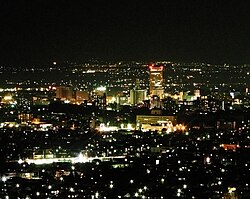There are many sources of light. The most common light sources are thermal: a body at a given temperature emits a characteristic spectrum of black-body radiation. Examples include sunlight

(the radiation emitted by the chromosphere of the Sun at around 6,000 K peaks in the visible region of the electromagnetic spectrum when plotted in wavelength units [1] and roughly 40% of sunlight is visible), incandescent light bulbs (which emit only around 10% of their energy as visible light and the remainder as infrared), and glowing solid particles in flames. The peak of the blackbody spectrum is in the infrared for relatively cool objects like human beings. As the temperature increases, the peak shifts to shorter wavelengths, producing first a red glow, then a white one, and finally a blue color as the peak moves out of the visible part of the spectrum and into the ultraviolet. These colors can be seen when metal is heated to "red hot" or "white hot". Blue thermal emission is not often seen. The commonly seen blue colour in a gas flame or a welder's torch is in fact due to molecular emission, notably by CH radicals (emitting a wavelength band around 425 nm).
Atoms emit and absorb light at characteristic energies. This produces "emission lines" in the spectrum of each atom. Emission can be spontaneous, as in light-emitting diodes, gas discharge lamps (such as neon lamps and neon signs, mercury-vapor lamps, etc.), and flames (light from the hot gas itself—so, for example, sodium in a gas flame emits characteristic yellow light). Emission can also be stimulated, as in a laser or a microwave maser.
Deceleration of a free charged particle, such as an electron, can produce visible radiation: cyclotron radiation, synchrotron radiation, and bremsstrahlung radiation are all examples of this. Particles moving through a medium faster than the speed of light in that medium can produce visible Cherenkov radiation.
Certain chemicals produce visible radiation by chemoluminescence. In living things, this process is called bioluminescence. For example, fireflies produce light by this means, and boats moving through water can disturb plankton which produce a glowing wake.
Certain substances produce light when they are illuminated by more energetic radiation, a process known as fluorescence. Some substances emit light slowly after excitation by more energetic radiation. This is known as phosphorescence.
Phosphorescent materials can also be excited by bombarding them with subatomic particles. Cathodoluminescence is one example of this. This mechanism is used in cathode ray tube television sets and computer monitors.

Certain other mechanisms can produce light:
- scintillation
- electroluminescence
- sonoluminescence
- triboluminescence
- Cherenkov radiation
When the concept of light is intended to include very-high-energy photons (gamma rays), additional generation mechanisms include:
- Radioactive decay
- Particle–antiparticle annihilation



0 comments:
Post a Comment